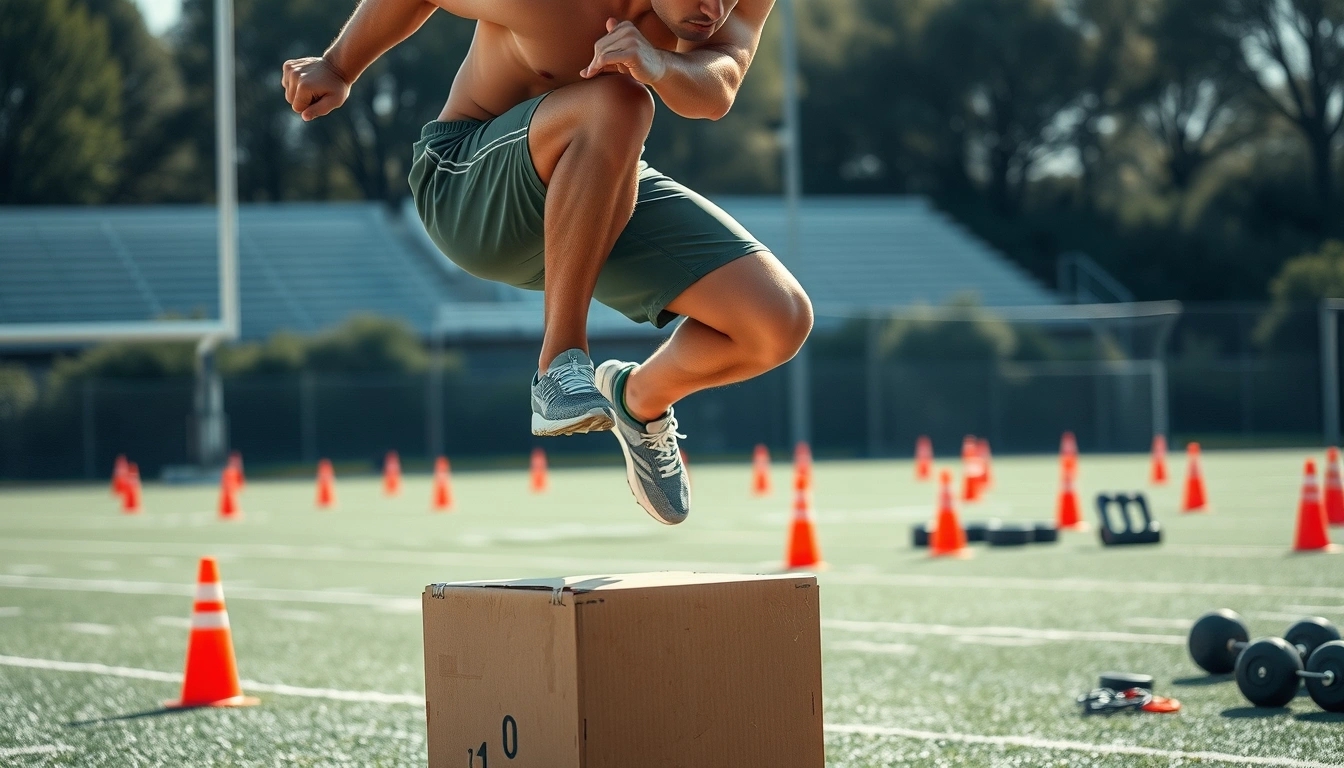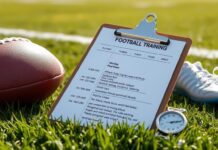Alright, let’s cut to the chase. Building functional power for football isn’t about just hoarding muscle like some gym rat obsessed with biceps bigger than their head. Nope, it’s about crafting that explosive force that launches you off the line, powers your tackles, and fuels those game-changing sprints. It’s the kind of power that screams, “I’m here to dominate” on the field, not just look good in a tank top.
So, what’s the deal with functional power? It’s not just raw strength or speed in isolation. It’s the sweet spot where strength meets agility and speed, all wrapped in a package that moves like a well-oiled machine. Think about it: a linebacker might bench press a ton, but if he can’t explode off the snap or change direction on a dime, that strength doesn’t do much good.
| Muscle Group | Role in Football |
|---|---|
| Glutes | Primary drivers for sprinting and explosive hip extension |
| Hamstrings | Assist in acceleration and deceleration, injury prevention |
| Core | Stabilizes the body during tackles and sudden movements |
| Quadriceps | Powerful knee extension for running and jumping |
| Upper Back & Shoulders | Crucial for effective blocking and tackling |
Now, if you’re just pounding iron without focusing on how your body moves on the field, you’re kinda missing the point. Enter plyometric training. These exercises—think box jumps, bounding, and explosive push-ups—are designed to recruit those fast-twitch muscle fibers that make you snap off the line like a coiled spring. And trust me, those fibers don’t get much love from slow, steady lifting sessions.
- Box Jumps: Builds vertical power and coordination.
- Depth Jumps: Trains muscles to absorb and then explode upward quickly.
- Medicine Ball Slams: Improves upper body explosiveness and core strength.
But wait, there’s always a “but,” right? Don’t confuse strength with power. Strength is your max force—how much you can lift or push. Power is how quickly you apply that force. Football demands both, but leaning too hard on strength without speed makes you a slow powerhouse, and too much speed without strength leaves you fragile and easy to knock over.
Strength Max Force (e.g., how much you can bench press)Power Force x Speed (how fast you can apply that force)
To keep things real, here’s a quick sample workout to get you started:
| Exercise | Sets | Reps | Focus |
|---|---|---|---|
| Squat Jumps | 3 | 8 | Explosiveness in lower body |
| Power Cleans | 4 | 5 | Full-body power |
| Medicine Ball Throws | 3 | 10 | Upper body explosiveness |
| Deadlifts | 4 | 6 | Strength foundation |
Don’t forget the fuel! Power gains don’t come from lifting alone. You gotta eat smart—protein to rebuild, carbs to refuel, and fats to keep hormones in check. And hydration? Non-negotiable.
Lastly, don’t be that guy who trains like a maniac but skips recovery. Your muscles need time to bounce back, or you’ll end up sidelined with injuries instead of scoring touchdowns. So, stretch, foam roll, and get your Z’s.
Long story short, building functional power for football is a mix of smart training, nutrition, and recovery—no shortcuts. It’s about being explosive, agile, and strong in the moments that count. If you’re ready to stop just “bulking up” and start playing like a beast, this is your blueprint.
Understanding Functional Power in Football
When we talk about functional power in football, it’s not just about who can bench press the most or run the fastest 40-yard dash. Nah, it’s way more complex than that. Functional power is the ability to generate explosive force in real-game situations — think sudden tackles, quick direction changes, or launching off the line like a missile. It’s the kind of power that actually matters on the field, not just in the weight room.
You see, raw strength is like having a big engine under the hood, but functional power? That’s knowing how to use that engine to drift around corners and accelerate when it counts. It’s a blend of strength, speed, coordination, and timing all rolled into one. Without it, a player might be strong but slow, or fast but weak — neither combo does much good when you’re trying to break through a defensive line or chase down a running back.
- Strength: The foundation — how much force your muscles can produce.
- Speed: How quickly you can apply that force.
- Coordination: The smoothness and timing of your movements.
- Balance and Stability: Keeping control while exerting power.
All these elements come together to create functional power. And here’s a little secret: it’s not just about lifting heavy weights. It’s about how you lift, how fast, and how explosively you move. Football players need to train in ways that mimic the unpredictable, high-intensity bursts of the game — no slow, controlled reps that look good on Instagram but don’t translate to the gridiron.
| Component | Description | Why It Matters |
|---|---|---|
| Explosiveness | Ability to generate maximum force in minimal time | Crucial for sprints, tackles, and jumps |
| Agility | Quick changes in direction without losing balance | Helps evade defenders and maintain control |
| Endurance | Maintaining power output throughout the game | Prevents fatigue from ruining your performance |
Now, don’t get me wrong — speed and strength still play starring roles, but functional power is the director calling the shots behind the scenes. It’s why some players who don’t look like bodybuilders still dominate the field — they’ve mastered the art of applying power in the right place at the right time. So next time you hear someone brag about their max squat, remind them functional power is the real MVP.
In short, functional power is the secret sauce that turns physical ability into football brilliance. It’s messy, complex, and sometimes frustrating to develop, but that’s what makes it so damn valuable. Train smart, train explosive, and watch your game transform.
Key Muscle Groups to Target
When it comes to football, everyone’s always yapping about speed and strength, but here’s the kicker: functional power is the real game-changer. And that means focusing on the right muscle groups—not just bulking up randomly in the gym. So, what muscles actually make you explode off the line, bulldoze through tackles, and sprint like you’re being chased by a pack of wild dogs? Let’s break it down.
- Quadriceps and Hamstrings: These bad boys are the engines behind every sprint, jump, and quick change of direction. The quads power your knee extension while the hamstrings handle the flexion, making sure you don’t face-plant when you try to cut left or right. Neglect these, and you’re basically asking for hamstring pulls or slow, clunky movements on the field.
- Glutes: Often overlooked, but oh-so-important. The gluteus maximus is the powerhouse for hip extension, which translates directly into your ability to explode forward. No strong glutes? Good luck pushing off the line or powering through tackles.
- Core Muscles: We’re talking abs, obliques, lower back—the whole shebang. A solid core stabilizes your entire body, allowing you to transfer power from lower to upper body seamlessly. Without it, your movements become sloppy, and you risk injury from awkward hits.
- Calves: These small muscles pack a punch in the sprint department. They help with ankle stability and push-off power, making your strides longer and quicker.
- Upper Back and Shoulders: Don’t forget the upper body! Functional power isn’t just legs. Strong traps, rhomboids, and deltoids help you absorb contact, maintain posture, and deliver those bone-crushing tackles.
Let’s visualize this with a quick table to keep it simple:
| Muscle Group | Primary Function | On-Field Benefit |
|---|---|---|
| Quadriceps & Hamstrings | Knee extension & flexion | Explosive sprints, quick cuts |
| Glutes | Hip extension | Powerful forward drives |
| Core | Body stabilization | Balance, injury prevention |
| Calves | Ankle stability & push-off | Speed, quick acceleration |
| Upper Back & Shoulders | Posture & contact absorption | Strong tackles, body control |
Now, here’s a little nugget of wisdom: just training muscles individually won’t cut it. Football demands functional, integrated movements. Meaning, your muscles gotta work together like a well-oiled machine. Ever seen a player with tree-trunk legs but can’t shake off a defender? Yeah, that’s what happens when you ignore coordination and functional strength.
So, how to train these muscle groups effectively? Plyometrics, compound lifts like squats and deadlifts, and core stability drills should be your bread and butter. Mix in some unilateral work (think single-leg deadlifts or lunges) because football isn’t symmetrical—your body rarely moves in perfect straight lines.
To wrap it up, here’s a quick checklist for your training focus:
- Prioritize explosive lower body strength (quads, hamstrings, glutes)
- Build a rock-solid core—no excuses!
- Don’t neglect calves for that extra push-off power
- Strengthen upper back for tackling and posture
- Train movements, not just muscles—functional power is king
Remember, football isn’t about looking like a bodybuilder; it’s about moving like a beast. Target these key muscle groups, and you’ll be the one making those jaw-dropping plays.

Explosive Plyometric Training
Alright, let’s dive headfirst into the wild world of plyometric exercises — those dynamic, high-intensity moves that are the secret sauce behind lightning-fast reactions and jaw-dropping power on the football field. Plyometrics aren’t just some fancy gym buzzword; they’re the real deal when it comes to awakening those quick-twitch muscle fibers that make you explode off the line or bulldoze through defenders.
So, what’s the big deal with quick-twitch fibers anyway? Think of your muscles like a hybrid car engine: slow-twitch fibers are the fuel-efficient cruise control, perfect for endurance, but quick-twitch fibers? They’re the nitro boost, firing up for rapid, forceful bursts. Plyometric training is like the mechanic tuning that engine, cranking up the power output just when you need it most — like a game-winning sprint or a bone-rattling tackle.
- Jump Squats: Start with feet shoulder-width apart, drop into a squat, then explode upward, landing softly. This move hammers your quads, glutes, and calves — the powerhouse trio for football.
- Bounding: Think exaggerated running strides, pushing off hard with each step. It’s a killer for hip flexors and hamstrings, building that elastic energy you need for those breakaway runs.
- Clap Push-Ups: Because regular push-ups are just too vanilla. These bad boys boost upper body power and chest explosiveness, crucial for those nasty blocks and stiff arms.
| Exercise | Primary Muscle Target | Benefit |
|---|---|---|
| Box Jumps | Glutes, Quads, Calves | Enhances vertical leap and leg power |
| Depth Jumps | Hamstrings, Calves | Improves reactive strength and ground contact time |
| Lateral Bounds | Hip Abductors, Glutes | Boosts lateral quickness and stability |
Now, don’t get cocky and think you can just jump around willy-nilly. Plyometric training is intense and demands respect. Overdoing it can lead to injuries faster than a linebacker blitzing the QB. The key is quality over quantity — explosive, controlled movements that teach your muscles to fire faster and harder.
Here’s a quick rundown of why plyometrics matter so much:
- Speed Meets Power: Plyometrics teach your muscles to contract rapidly, translating strength into speed — a combo every football player craves.
- Game-Day Performance: When you’ve got tired legs late in the game, plyometric training helps maintain that snap in your step, keeping you sharp when it counts.
- Injury Prevention: By improving neuromuscular coordination, plyos help your body handle sudden changes in direction and impact — less chance of those pesky strains and sprains.
But hey, if you’re just starting, don’t be that guy trying to do 100 box jumps on day one. Build up gradually, listen to your body, and mix plyos with strength and flexibility work. It’s a package deal.
Remember, the beauty of plyometric training isn’t just in the raw numbers — it’s how it makes you feel on the field. When your muscles snap tighter, your reactions get sharper, and your plays look downright explosive, that’s when you know you’re onto something.
So, lace up, get ready to jump, bound, and clap your way to football greatness. Your quick-twitch fibers will thank you — and so will your highlight reel.
Strength vs. Power: What’s the Difference?
Alright, let’s cut through the noise and get real about strength and power—two terms that get tossed around in football circles like a hot potato, but honestly, many folks mix them up like peanut butter and jelly. They’re related, sure, but not the same beast. Understanding the difference isn’t just for the science nerds; it’s crucial if you want to dominate on the gridiron without burning out or getting stuck in the weight room rut.
First up, strength. Think of strength as your maximum muscle force—the sheer grunt power you can muster, no matter how slow or fast. It’s like when a defensive lineman plants his feet and refuses to budge against a double team. Strength is the foundation, the raw capacity to push, pull, or lift heavy loads. But here’s the kicker: strength alone won’t make you the fastest or the most explosive player out there.
Now, power is where things get spicy. Power is all about speed and strength combined—how quickly you can apply that force. Imagine a running back bursting through a hole or a linebacker exploding off the line for a sack. That’s power in action. It’s measured as force times velocity, which means you can be strong but slow, or fast but weak, but the sweet spot is having both.
| Attribute | Strength | Power |
|---|---|---|
| Definition | Maximum force muscle can produce | Force applied quickly (force × speed) |
| Example | Squatting max weight | Explosive jump or sprint |
| Training Focus | Heavy lifting, low reps | Explosive movements, plyometrics |
| Football Application | Holding ground against blockers | Quick tackles, fast breaks |
So why does football demand a balance of both? Well, if you’re just strong but lumbering, you’re basically a tank without the turbo boost. You’ll push people around but won’t get to the ball carrier fast enough to make a difference. On the flip side, if you’re all quickness and no strength, you might get blown off the line or pushed aside like a rag doll. The game demands you to be a hybrid—strong enough to impose your will physically, but explosive enough to make game-changing plays.
- Strength builds the muscle and resilience to handle contact and maintain position.
- Power allows you to accelerate, jump, and react faster than your opponent.
- Ignoring one for the other? That’s a recipe for underperformance and potential injury.
Here’s a practical tidbit: training for football power isn’t about just maxing out on the bench press or squats. It’s about how you apply that strength quickly. Plyometrics, Olympic lifts, and sprint drills are your best friends here—they teach your muscles to fire in lightning speed.
Example Power Training Drill:- 3 sets of 5 explosive box jumps- 4 sets of 3 power cleans at 75% max- 5 sets of 20-meter sprints with full recovery
In the end, the magic formula for football success is this: build a rock-solid strength base, then train your body to unleash that force like a coiled spring. That combo will have you bulldozing through blockers and darting past defenders before they even blink. So next time you hit the gym, don’t just chase heavy weights—chase functional power. Your game will thank you.
Sample Workout Routine for Functional Power
Alright, let’s cut through the fluff and get straight to the meat of it — a workout plan that actually does the job for football players craving that explosive edge on the field. Forget endless hours of pointless reps or fancy gym machines that make you look busy but don’t pack a punch where it counts. This routine is all about functional power, meaning moves that translate directly into those game-winning sprints, tackles, and jumps.
- Warm-Up (10 minutes): Dynamic stretches like leg swings, arm circles, and high knees. No static stretching here — we want muscles ready to explode, not snooze.
- Power Circuit (3 rounds):
- Box Jumps – 8 reps: Builds explosive leg drive. Find a sturdy box or bench, jump up, land softly, reset.
- Medicine Ball Slams – 12 reps: Great for core and upper body power. Slam that ball like you mean it.
- Deadlifts – 6 reps: Focus on form, heavy enough to challenge but not wreck your back.
- Broad Jumps – 5 reps: Measure your distance, push yourself to go farther every round.
- Push Press – 8 reps: Explosive overhead press to develop shoulder and tricep power.
- Speed & Agility Drills (15 minutes):
- 5 x 20-yard sprints with full recovery.
- Agility ladder drills focusing on quick feet and coordination.
- Cool Down & Mobility (10 minutes): Foam rolling, hip flexor stretches, and deep breathing to reset.
Now, here’s a quick table to keep track of your progress and make sure you’re not slacking off:
| Exercise | Sets | Reps | Weight/Distance | Notes |
|---|---|---|---|---|
| Box Jumps | 3 | 8 | Height of box | Land softly, explode up |
| Medicine Ball Slams | 3 | 12 | 10-15 lbs ball | Use full body |
| Deadlifts | 3 | 6 | Heavy but safe | Form over ego |
| Broad Jumps | 3 | 5 | Distance | Measure and improve |
| Push Press | 3 | 8 | Moderate weight | Explode upward |
Look, functional power isn’t built by just lifting heavy or running till you drop. It’s about quality and intent. Every rep should be deliberate, every movement sharp. If you’re just going through the motions, you might as well be watching football on your couch.
But hey, don’t get cocky. Recovery is king. Without proper rest, your muscles won’t rebuild, and your power gains will stall faster than a rookie fumbling a snap. Also, don’t forget to fuel up with good nutrition — protein, carbs, and fats in the right balance. No, that doesn’t mean eating pizza before practice, tempting as that sounds.
In the end, this workout is a framework — tweak it, push yourself, listen to your body. Functional power is a beast that requires respect and patience. Stick with it, and you’ll notice those explosive plays aren’t just luck, but the result of smart, hard training.
Pro Tip: Track your jumps and sprints weekly. Small improvements add up and keep you motivated.
So, ready to get off the bench and into beast mode? Let’s make those gains count!

Nutrition Tips to Support Power Gains
Alright, let’s cut to the chase: if you’re a football player looking to pack on some serious power, you can’t just live off energy drinks and hope for the best. Nutrition is the secret sauce that fuels your muscles to grow and bounce back after those brutal training sessions. Think of your body like a high-performance engine — if you don’t put the right fuel in it, you’re not going anywhere fast.
Protein is your best friend. No surprises here. It’s the building block of muscle, plain and simple. But not all protein is created equal. You want a mix of fast-absorbing proteins like whey right after workouts to kickstart recovery, and slower-digesting ones like casein before bed to keep those muscles fed overnight. Aim for about 1.6 to 2.2 grams of protein per kilogram of body weight daily. Yeah, that sounds like a lot, but it’s necessary if you want those gains.
| Protein Sources | Why They Rock |
|---|---|
| Chicken Breast | Lean, high-quality protein with minimal fat |
| Eggs | Complete protein with essential amino acids |
| Greek Yogurt | Rich in casein and probiotics for gut health |
| Whey Protein | Fast absorption post-workout |
| Tofu/Tempeh | Great plant-based options for vegetarians |
Now, carbs often get a bad rap, but for football players, they’re the MVP. Carbs are your main energy source, especially during those explosive sprints and tackles. Without enough carbs, your body starts munching on protein for energy — not ideal when you’re trying to build muscle. Load up on complex carbs like sweet potatoes, brown rice, oats, and whole grains. And don’t forget timing: having carbs before and after workouts replenishes glycogen stores and speeds up recovery.
- Pre-Workout: A balanced meal with carbs and protein about 1.5-2 hours before hitting the gym.
- Post-Workout: Carbs + protein within 30 minutes after training to maximize muscle repair.
Hydration? Oh, it’s way more important than most people realize. Dehydration can tank your power output faster than you can say “touchdown.” Water keeps your muscles firing and joints lubricated. If you’re sweating buckets, consider electrolyte drinks to replace sodium, potassium, and magnesium lost during intense sessions.
Now, let’s talk fats — but not the villainous kind. Healthy fats like omega-3s help reduce inflammation and support hormone production (hello, testosterone!). Sources like salmon, walnuts, flaxseeds, and avocados should be regulars on your plate.
Quick Nutrition Checklist for Power-Building Footballers:- Protein: 1.6-2.2 g/kg body weight daily- Carbs: Prioritize complex carbs, focus on timing- Fats: Include omega-3 rich foods- Hydration: Drink water consistently; add electrolytes post-training- Supplements: Creatine, BCAAs, and fish oil can be helpful but aren’t magic bullets
One last nugget: don’t skimp on calories. Trying to build power on a calorie deficit? Yeah, good luck with that. You need a slight surplus to provide the energy for muscle growth and recovery. But keep it clean — junk food overload will just leave you sluggish and out of shape.
In the end, nutrition isn’t rocket science, but it does require some discipline and planning. Mix the right foods, time your meals smartly, and don’t forget to hydrate like your game depends on it — because it does.
Remember: You can lift all the weights in the world, but without proper nutrition, your muscles won’t reach their true power potential.
Common Mistakes to Avoid
Power training for football players sounds like a no-brainer — lift heavy, jump high, run fast, right? Well, not exactly. There’s a minefield of common pitfalls that can turn your quest for explosive power into a frustrating, injury-riddled mess. Let’s break down some of the biggest blunders players often stumble into and how you can sidestep them like a pro.
- Overloading Too Soon: Trying to add weight or intensity too quickly is like trying to sprint before you can walk. It’s tempting to chase those big numbers on the barbell, but your muscles and joints need time to adapt. Jumping into heavy squats or power cleans without proper progression can lead to strains or worse. Patience, young grasshopper.
- Neglecting Technique: Power isn’t just about brute force — it’s about how efficiently you apply it. Sloppy form on explosive lifts or plyometric drills doesn’t just waste effort; it’s a fast track to injury. For example, landing incorrectly during box jumps can wreck your knees. So, slow down, focus on form, and get a coach or buddy to check your moves.
- Ignoring Recovery: If you’re grinding out power workouts every day without giving your body a break, you’re basically asking for burnout or injury. Muscles need time to repair and grow stronger. Skipping rest days or sleep? Big no-no. Your gains happen when you’re off the field, not just when you’re sweating buckets.
| Mistake | Why It Happens | How to Avoid |
|---|---|---|
| Overtraining | Desire to improve fast, lack of recovery awareness | Schedule rest days, listen to your body, prioritize sleep |
| Poor Technique | Rushing exercises, lack of coaching | Focus on form, use mirrors or video, get professional feedback |
| Skipping Warm-Ups | Impatience, underestimating injury risk | Always spend 10-15 mins warming up dynamically |
| One-Dimensional Training | Focusing only on strength or only on speed | Incorporate balanced workouts targeting strength, power, and agility |
Now, here’s a not-so-obvious trap: falling into the “muscle bulk” illusion. Some players think piling on muscle mass automatically means more power. But football power is a cocktail of strength, speed, and coordination. Too much bulk without functional training can slow you down and mess with your explosiveness. So, don’t just chase size — chase smart, purposeful power.
Another sneaky mistake? Neglecting the core and stabilizer muscles. It’s easy to get obsessed with the big lifts and forget the smaller muscles that protect your spine and improve balance. Weak stabilizers can lead to poor movement patterns and injuries during those sudden cuts or tackles.
Quick Tips to Dodge Common Pitfalls:- Warm up properly every session- Progress intensity gradually, no ego lifting- Prioritize technique over numbers- Balance your training: strength, speed, agility- Don’t skip rest and recovery- Strengthen your core and stabilizers- Listen to your body; pain isn’t just “part of the game”
In the end, power training isn’t just about grinding harder — it’s about training smarter. Avoid these common mistakes, and you’ll not only boost your explosive game-day moves but also keep your body in one piece season after season. Because let’s be honest, nothing kills your highlight reel faster than a trip to the sidelines with an avoidable injury.
Stay sharp, train smart, and bring that power to the field — minus the pitfalls!
Recovery and Injury Prevention
When it comes to football, everyone’s buzzing about those grueling workouts, the explosive drills, and the muscle gains. But here’s the kicker: recovery isn’t just some optional add-on or “nice-to-have” — it’s the secret sauce that keeps functional power ticking all season long. Without proper recovery, you’re basically throwing all that hard-earned training out the window. Seriously, you can’t just hammer your body day in and day out and expect to get stronger, faster, or more explosive without giving it some TLC.
Think of your body like a high-performance engine. You wouldn’t drive a race car non-stop without pit stops, right? Same deal here. Recovery lets your muscles repair, rebuild, and get ready to smash the next session. Skipping this step? That’s a fast track to burnout or injury, and nobody wants to be sidelined with a pulled hammy or worse. Functional power isn’t just about how hard you train but how well you bounce back. Rest days, quality sleep, and active recovery (think light jogging, stretching, or yoga) are all part of the package.
| Key Recovery Components | Why They Matter |
|---|---|
| Sleep | Muscle repair and hormone balance happen mostly during deep sleep phases. No sleep no gains. |
| Nutrition | Fueling your body with protein, carbs, and healthy fats helps rebuild muscle tissue and replenish energy stores. |
| Hydration | Staying hydrated prevents cramps and supports overall cellular function. |
| Active Recovery | Light movement helps flush out toxins and reduces muscle soreness. |
| Massage/Foam Rolling | Breaks up knots and improves blood flow to tired muscles. |
Now, let’s talk injury prevention — because functional power means squat, sprint, and tackle without the fear of pulling a muscle or tweaking a joint. Football players are prone to all sorts of strains and sprains, especially when they push too hard or neglect flexibility and mobility work. Incorporating dynamic warm-ups before training and cool-down stretches afterward isn’t just for show — it’s a must.
- Dynamic Warm-Ups: Get your muscles firing and joints lubricated with movements like leg swings, high knees, and arm circles.
- Mobility Drills: Keep those hips, ankles, and shoulders loose to prevent awkward movements that cause injuries.
- Strengthening Stabilizers: Don’t just focus on the big muscles. Strengthen smaller stabilizer muscles to support joints and improve balance.
Here’s a quick reality check: even the best training program won’t do squat if you’re nursing an injury mid-season. So, listen to your body — that nagging ache might be a warning sign, not something to tough out. Ice, compression, elevation, and professional advice when needed can save you weeks of downtime.
Recovery + Injury Prevention Functional Power That Lasts---------------------------------------------------------Train hard, yes — but recover harder.Your muscles need time to rebuild stronger.Injury prevention keeps you on the field, not the bench.
In the end, balancing training intensity with smart recovery strategies is what separates the weekend warriors from the game-day heroes. So, next time you’re tempted to skip that rest day or ignore your sore muscles, remember: recovery isn’t weakness, it’s your power-building partner. Without it, all the explosive drills and heavy lifting won’t mean a thing once fatigue and injuries start creeping in. Stay sharp, stay smart, and watch your functional power soar — injury-free.

Tracking Progress: Metrics That Matter
Alright, so you’ve been grinding hard, pushing through those brutal plyo sessions and deadlifts, but how on earth do you actually know if your functional power is improving? It’s not like you can just look in the mirror and see “more explosive.” Nope, tracking progress in functional power needs a bit more finesse than that. Let’s break down some practical ways to keep your training honest and your motivation sky-high.
First off, forget relying solely on how much weight you can lift. Sure, strength is important, but functional power is all about how quickly and explosively you can use that strength in game-like situations. Think sprint speed, jump height, and reactive movements. So, what are the reliable metrics? Here’s a quick rundown:
- Vertical Jump Test: Measures explosive lower-body power. Simple, effective, and you can do it with just a wall and a measuring tape.
- 40-Yard Dash: Classic for a reason. Tracks your acceleration and speed—a direct indicator of your power translating to the field.
- Medicine Ball Throw: Shows upper body explosive strength. Plus, it’s kinda fun to chuck a heavy ball as far as you can.
- Reactive Agility Drills: Timed drills that test how quickly you can change direction. Because football isn’t just about running straight.
| Metric | What It Measures | Why It Matters | How Often to Test |
|---|---|---|---|
| Vertical Jump | Lower body explosive power | Improves tackling, jumping for catches | Every 4-6 weeks |
| 40-Yard Dash | Acceleration and speed | Crucial for sprints and breakaway plays | Every 6-8 weeks |
| Medicine Ball Throw | Upper body power | Enhances blocking and throwing power | Every 6 weeks |
| Reactive Agility | Change of direction speed | Vital for evading defenders | Monthly |
Now, here’s the kicker: tracking numbers is only half the battle. You gotta keep your training focused and your mindset sharp. Setting realistic, incremental goals based on these metrics keeps you accountable. For example, shaving off 0.1 seconds on your 40-yard dash might seem tiny, but in football, that’s a game-changer. Celebrate small wins to keep the fire alive!
Also, don’t be that guy who tests once, sees no improvement, and throws in the towel. Functional power gains don’t happen overnight. Be patient, consistent, and keep tweaking your training based on what the numbers say. It’s like tuning a guitar—you gotta listen carefully and adjust. If your vertical jump plateaus, maybe add more plyometrics. If your agility stalls, incorporate more reactive drills.
Finally, technology can be your best friend here. Devices like GPS trackers, accelerometers, and even smartphone apps can provide real-time feedback on your speed and explosiveness. Sure, it sounds fancy, but even simple stopwatch timings and jump measurements work wonders when done regularly.
In the end, measuring functional power isn’t rocket science, but it does require a bit of dedication and honesty. Track the right metrics, stay consistent, and keep your eyes on the prize. Because when those numbers start climbing, you’ll feel that boost on the field—and that’s what it’s all about.
Frequently Asked Questions
- What exactly is functional power in football?
Functional power isn’t just about lifting heavy weights or running fast. It’s the ability to generate explosive force quickly during real football movements—think sprinting, tackling, or jumping. It’s like having a turbo boost that kicks in right when you need it on the field.
- How do I train to build functional power instead of just bulk?
Focus on explosive exercises like plyometrics and dynamic lifts that mimic football actions. Instead of slow, heavy lifting, go for quick, powerful movements that engage your fast-twitch muscle fibers. This approach trains your body to explode into action, not just look strong in the gym.
- Which muscle groups should I prioritize for better football power?
Your legs, hips, core, and upper back are the powerhouses here. These muscles drive your explosive sprints, tackles, and changes in direction. Strengthening these areas with targeted exercises will make your game-day moves sharper and more forceful.
- What’s the difference between strength and power, and why does football need both?
Strength is how much force you can produce, like how heavy you can lift. Power combines that strength with speed—how fast you can apply that force. Football demands both because you need to be strong to hold your ground and powerful to move explosively when it counts.
- Can nutrition really impact my power gains?
Absolutely! Your muscles need the right fuel to grow and recover quickly. A balanced diet rich in protein, healthy fats, and carbs supports muscle repair and energy levels, helping you bounce back faster and train harder for those explosive plays.
- How important is recovery in building functional power?
Recovery is like the secret sauce—it lets your muscles repair and grow stronger after intense training. Skipping rest can lead to injury or burnout, killing your progress. Prioritize sleep, stretching, and active recovery to keep your power levels peaking all season long.
- What are common mistakes to avoid when training for functional power?
Don’t just chase heavy weights or neglect proper form. Overtraining, ignoring mobility, and skipping warm-ups can cause injuries or stall progress. Focus on quality movements, listen to your body, and balance training with recovery to get the best results.
- How can I track my progress in building functional power?
Use measurable metrics like sprint times, vertical jump height, and explosive lift numbers. Regularly testing these helps you see real improvements and adjust your training to stay on track—think of it as your personal performance dashboard.












